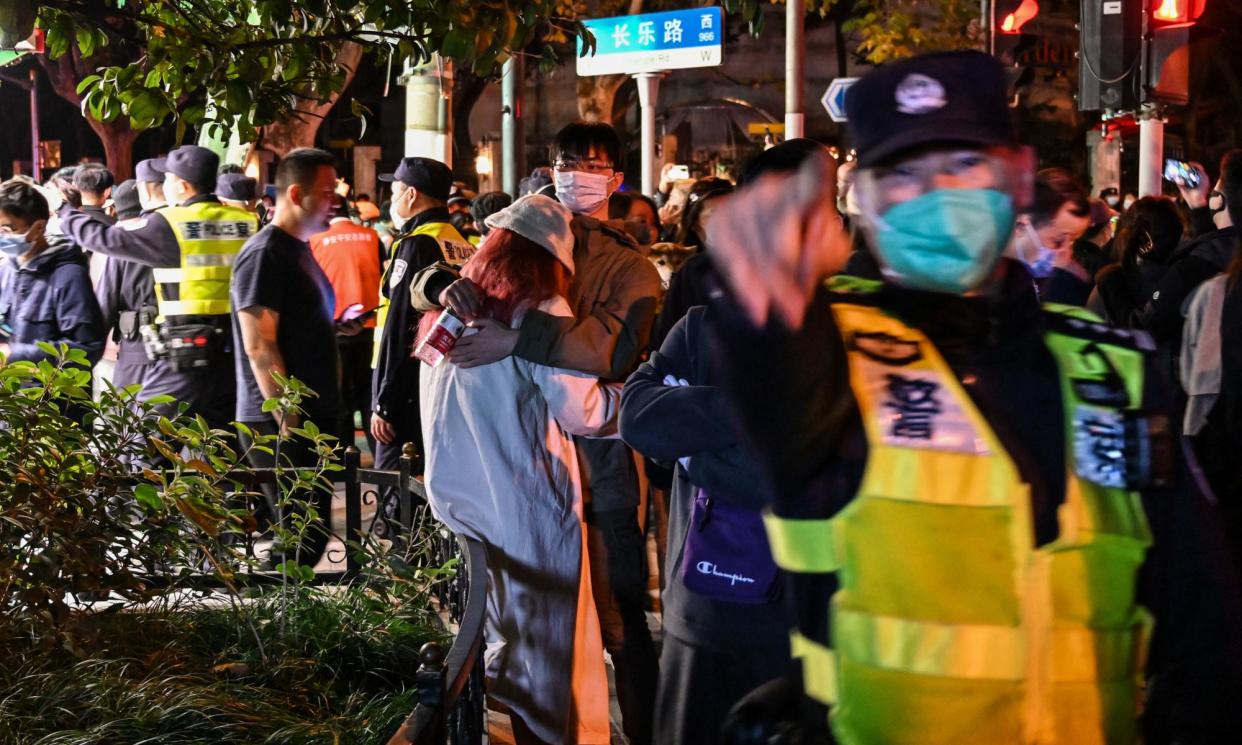China erases memory of ‘white paper’ protests in further threat to journalism

In November 2022, thousands of people took to the streets across China to protest against the government’s strict Covid-19 controls in an unprecedented wave of civil disobedience. They were thought to be the largest protests since the 1989 pro-democracy Tiananmen Square demonstrations when, at its height, a million people are estimated to have gathered.
It started in Shanghai with a vigil mourning victims of a deadly apartment fire in the western Xinjiang region, which saw some of the country’s most intense lockdowns.
At dusk, people began spontaneously gathering with candles and flowers in the city’s Wulumuqi Road, named after Xinjiang’s capital, Urumqi. As the night wore on, the event evolved into a rare protest, with demonstrators expressing anger not only against Covid restrictions but also the Chinese leadership.
Some reportedly chanted: “Down with the Chinese Communist party”, while others held up blank sheets of paper to mock the regime’s censorship.
This act of defiance, known as the “white paper” protests, spread like wildfire across the country and ended in clashes between demonstrators and police. But the demonstrations were effective: weeks later, the government abruptly ended its “zero-Covid” policy.
Few traces of the movement remain in China. Authorities have since censored online reporting of the event and silenced those who dared to document or commemorate it. Among them is Chen Pinlin, a film-maker who released a film about the demonstrations on YouTube and X, both inaccessible in China, to mark the first anniversary of the protests.
Chen, who goes by the pseudonym “Plato”, was arrested in January by Shanghai police and held at Baoshan detention centre. On 18 February, he was charged with “picking quarrels and provoking trouble”, which carries a sentence of up to five years in prison, according to the New York-based Committee to Protect Journalists (CPJ).
The CPJ says Beijing is cracking down on any form of public memory of the protests. “Chen’s case sends a message to other aspiring citizen journalists that says: don’t try this, we’ll be coming after you,” says Beh Lih Yi, the head of CPJ’s Asia programme.
The Chinese state has long ranked as one of the world’s worst jailers of journalists and was listed as the top offender by the CPJ last year, but the space for journalism appears to be shrinking further.
In addition to tightening its censorship, the government has ramped up its national security messaging, warning citizens to guard against foreign espionage. The party has long promulgated the idea of a threat from “foreign hostile forces” as a means to divert criticism of its leadership – a tactic also used during the white paper protests.
In recent years, it has become more common for journalists to be sentenced under “anti-state” charges, Beh says. One example is Sophia Huang Xueqin, an imprisoned #MeToo journalist who has been charged with “inciting subversion of state power”.
Minjia*, a Chinese journalist in her 20s in Beijing, says the propaganda has had a chilling effect. While it has always been difficult to find sources willing to speak with journalists, people are now increasingly concerned about “security” and falling under police scrutiny for accepting interviews, even if they want to contribute, she says.
“The propaganda is causing people to distrust and fear the media,” Minjia says. “I heard that some Chinese media journalists have also been called ‘foreign forces’, which is ridiculous. The saddest thing is when we’re attacked by normal people … It feels so much worse than being [accused] by police.”
It is difficult now for any media organisation apart from CCTV, China’s state broadcaster, to gain on-the-ground access during breaking news, Minjia adds. “When we get there, usually the police have already blocked access. Before, it wasn’t that quick.”
Related: Threats, fear and surveillance: how Beijing targets students in the UK who criticise regime
According to the advocacy group Reporters without Borders (RSF), at least 119 journalists and press-freedom defenders are in detention. Of them, three are in Tibet, 10 are in Hong Kong and 77 are in Xinjiang, including Ilham Tohti – a prominent Uyghur professor and co-founder of the website Uyghur Online – and seven of his students. But the total number of those detained could be higher.
Aleksandra Bielakowska, RSF’s advocacy officer, says pandemic-era restrictions on accessing information have yet to be lifted, despite the end of zero-covid. “It’s starting to be very difficult to find information on people detained four years ago; if they’re even alive, which detention centres they’re in,” she says.
The decline in press freedoms is in part due to Beijing’s swift and sweeping crackdown in Hong Kong since the passing of a national security law in 2020. Last month, Bielakowska was detained for six hours upon arrival in Hong Kong and then deported. She had intended to enter the city to monitor the national security trial of local media tycoon Jimmy Lai.
As journalism in China contracts, more Chinese people are seeking to tell their stories abroad. Mang Mang, an independent Chinese magazine in Europe born out of the white paper protests, is emblematic of such efforts. The platform consists of young citizen journalists and activists who are interested in empowering Chinese communities, says Beishan Chen*, one of its members.
“We want to make a platform for activists to document themselves, for journalists to continue their work,” Chen says. “After the protests, we don’t despair; we’re bringing energy from China to outside of China.”
* Names have been changed


